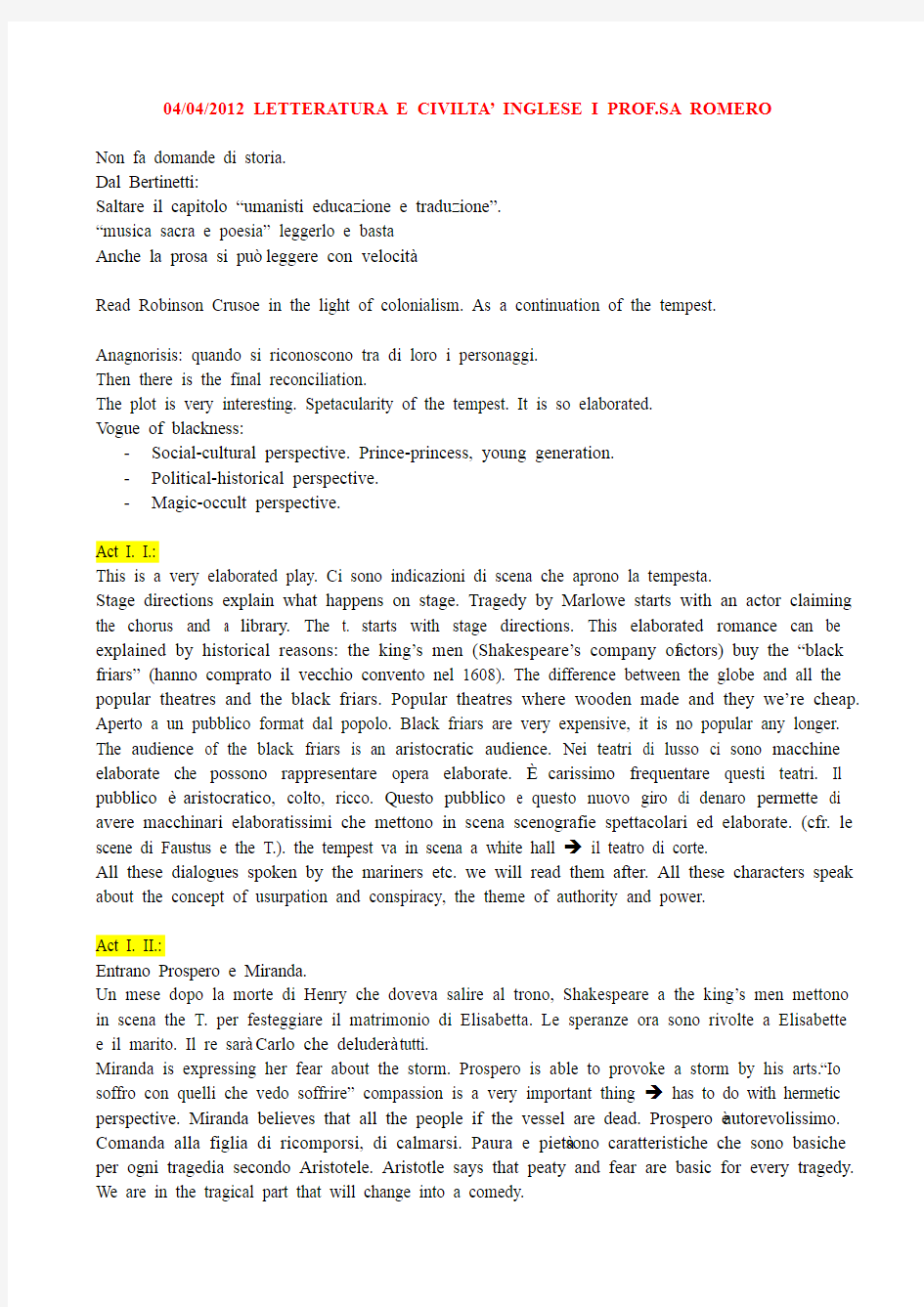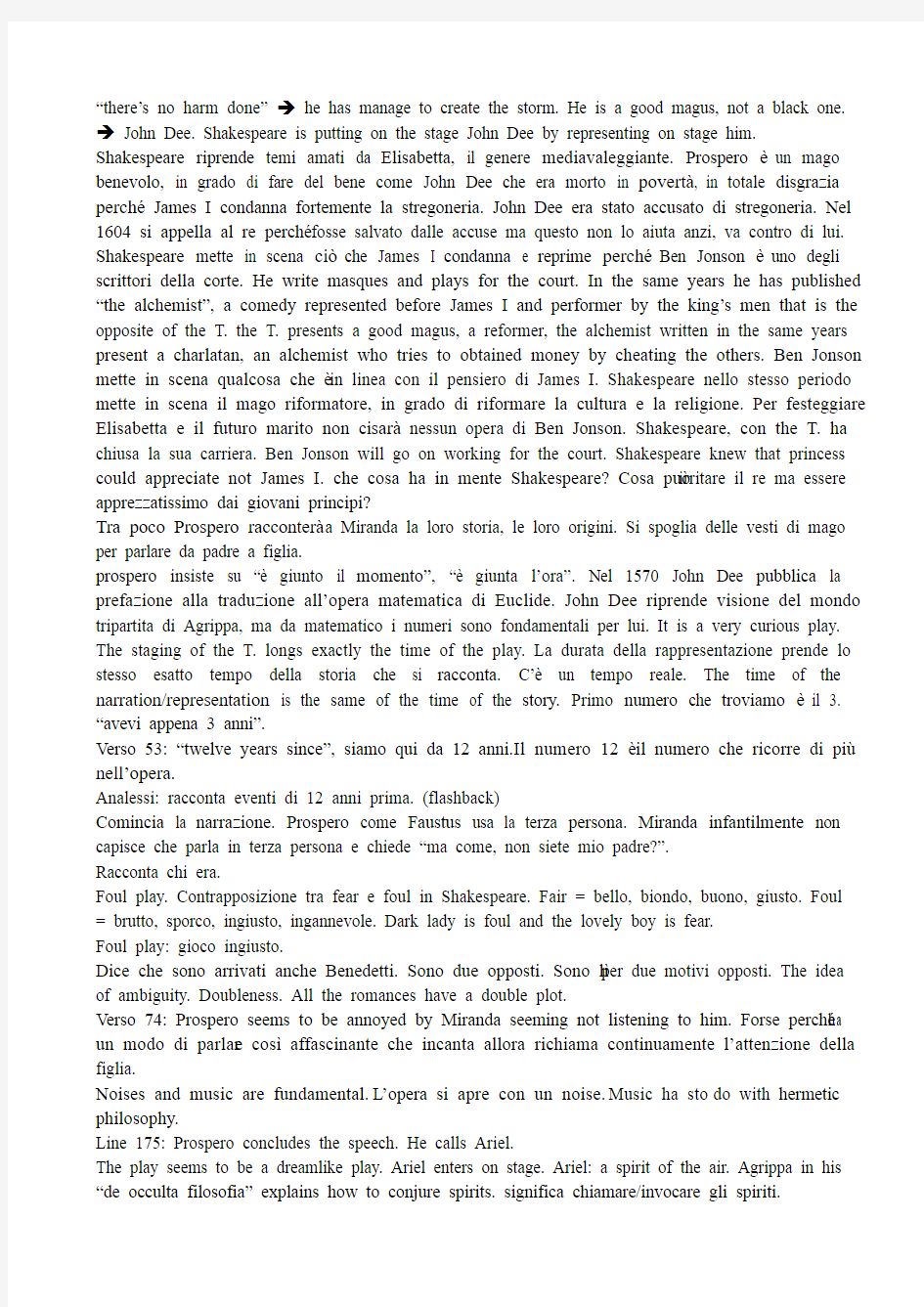letteratura e civiltà inglese I


04/04/2012 LETTERATURA E CIVILTA’ INGLESE I PROF.SA ROMERO
Non fa domande di storia.
Dal Bertinetti:
Saltare il capitolo “umanisti educazione e traduzione”.
“musica sacra e poesia” leggerlo e basta
Anche la prosa si può leggere con velocità.
Read Robinson Crusoe in the light of colonialism. As a continuation of the tempest. Anagnorisis: quando si riconoscono tra di loro i personaggi.
Then there is the final reconciliation.
The plot is very interesting. Spetacularity of the tempest. It is so elaborated.
Vogue of blackness:
-Social-cultural perspective. Prince-princess, young generation.
-Political-historical perspective.
-Magic-occult perspective.
Act I. I.:
This is a very elaborated play. Ci sono indicazioni di scena che aprono la tempesta.
Stage directions explain what happens on stage. Tragedy by Marlowe starts with an actor claiming the chorus and a library. The t. starts with stage directions. This elaborated romance can be explained by historical reasons: the king’s men (Shakespeare’s company of actors) buy the “black friars” (hanno comprato il vecchio convent o nel 1608). The difference between the globe and all the popular theatres and the black friars. Popular theatres where wooden made and they we’re cheap. Aperto a un pubblico format dal popolo. Black friars are very expensive, it is no popular any longer. The audience of the black friars is an aristocratic audience. Nei teatri di lusso ci sono macchine elaborate che possono rappresentare opera elaborate. ècarissimo frequentare questi teatri. Il pubblico èaristocratico, colto, ricco. Questo pubblico e questo nuovo giro di denaro permette di avere macchinari elaboratissimi che mettono in scena scenografie spettacolari ed elaborate. (cfr. le scene di Faustus e the T.). the tempest va in scena a white hall → il teatro di corte.
All these dialogues spoken by the mariners etc. we will read them after. All these characters speak about the concept of usurpation and conspiracy, the theme of authority and power.
Act I. II.:
Entrano Prospero e Miranda.
Un mese dopo la morte di Henry che doveva salire al trono, Shakespeare a the king’s men mettono in scena the T. per festeggiare il matrimonio di Elisabetta. Le speranze ora sono rivolte a Elisabette e il marito. Il re sarà Carlo che deluderà tutti.
Miranda is expressing her fear about the storm. Prospero is able to provoke a storm by his arts. “Io soffro con quelli che vedo soffrire” compassion is a very important thing → has to do with hermetic perspective. Miranda believes that all the people if the vessel are dead. Prospero è autorevolissimo. Comanda alla figlia di ricomporsi, di calmarsi. Paura e pietà sono caratteristiche che sono basiche per ogni tragedia secondo Aristotele. Aristotle says that peaty and fear are basic for every tragedy. We are in the tragical part that will change into a comedy.
“there’s no harm done” → he has manage to create the storm. He is a good magus, not a black one. → John Dee. Shakespeare is putting on the stage John Dee by representing on stage him. Shakespeare riprende temi amati da Elisabetta, il genere mediavaleggiante. Prospero èun mago benevolo, in grado di fare del bene come John Dee che era morto in povertà, in totale disgrazia perché James I condanna fortemente la stregoneria. John Dee era stato accusato di stregoneria. Nel 1604 si appella al re perché fosse salvato dalle accuse ma questo non lo aiuta anzi, va contro di lui. Shakespeare mette in scena ciòche James I condanna e reprime perchéBen Jonson èuno degli scrittori della corte. He write masques and plays for the court. In the same years he has published “the alchemist”, a comedy represented before James I and performer by the king’s men that is the opposite of the T. the T. presents a good magus, a reformer, the alchemist written in the same years present a charlatan, an alchemist who tries to obtained money by cheating the others. Ben Jonson mette in scena qualcosa che è in linea con il pensiero di James I. Shakespeare nello stesso periodo mette in scena il mago riformatore, in grado di riformare la cultura e la religione. Per festeggiare Elisabetta e il futuro marito non ci sarà nessun opera di Ben Jonson. Shakespeare, con the T. ha chiusa la sua carriera. Ben Jonson will go on working for the court. Shakespeare knew that princess could appreciate not James I. che cosa ha in mente Shakespeare? Cosa può irritare il re ma essere apprezzatissimo dai giovani principi?
Tra poco Prospero racconterà a Miranda la loro storia, le loro origini. Si spoglia delle vesti di mago per parlare da padre a figlia.
prospero insiste su “è giunto il momento”, “è giunta l’ora”. Nel 1570 John Dee pubblica la prefazione alla traduzione all’opera matematica di Euclide. John Dee riprende visione del mondo tripartita di Agrippa, ma da matematico i numeri sono fondamentali per lui. It is a very curious play. The staging of the T. longs exactly the time of the play. La durata della rappresentazione prende lo stesso esatto tempo della storia che si racconta. C’è un tempo reale. The time of the narration/representation is the same of the time of the story. Primo numero che troviamo èil 3. “avevi appena 3 anni”.
Verso 53: “twelve years since”, siamo qui da 12 anni. Il numero 12 è il numero che ricorre di piùnell’opera.
Analessi: racconta eventi di 12 anni prima. (flashback)
Comincia la narrazione. Prospero come Faustus usa la terza persona. Miranda infantilmente non capisce che parla in terza persona e chiede “ma come, non siete mio padre?”.
Racconta chi era.
Foul play. Contrapposizione tra fear e foul in Shakespeare. Fair = bello, biondo, buono, giusto. Foul = brutto, sporco, ingiusto, ingannevole. Dark lady is foul and the lovely boy is fear.
Foul play: gioco ingiusto.
Dice che sono arrivati anche Benedetti. Sono due opposti. Sono lì per due motivi opposti. The idea of ambiguity. Doubleness. All the romances have a double plot.
Verso 74: Prospero seems to be annoyed by Miranda seeming not listening to him. Forse perché ha un modo di parlar e così affascinante che incanta allora richiama continuamente l’attenzione della figlia.
Noises and music are fundamental. L’opera si apre con un noise. Music ha sto do with hermetic philosophy.
Line 175: Prospero concludes the speech. He calls Ariel.
The play seems to be a dreamlike play. Ariel enters on stage. Ariel: a spirit of the air. Agrippa in his “de occulta filosofia” explains how to conjure spirits. significa chiamare/invocare gli spiriti.
Prospero è il mago buono in grado di evocare spiriti benigni.
Anche per Ariel ci vogliono meccanismi elaboratissimi per metterlo in scena. Ci vogliono acchinari elaboratissimi per far volare in scena uno spiritello.
Anche il nome Ariel è derivato da Agrippa, è uno degli spiriti convocati da Agrippa. Atteggiamento servile, gentilissimo. Grande maestro → magro di grande livello.
Master = maestro, signore, padrone.
Si offre di volare o di cavalcare le nuvole, si offre di toccare l’aria. Si offre anche di nuotare, quindi tocca l’acqua. E si offre anche di toccare il fuoco. Manca l’elemento della terra, l’elemento vile che appartiene a Caliban. Ariel ha a che fare solo con gli elementi nobili. (cfr. teoria degli umori). Caliban è un essere inferiore che tratta elementi bassi (terra).
Sappiamo che è stato Ariel a dar fuoco alla nave comandato da Prospero.
Verso 226: mezzanotte →ancora il 12. Mezzanotte è l’ora dei maghi, delle streghe. Rugiada elemento magico per gli alchimisti. Rugiada è solida e liquida contemporaneamente.
Non sappiamo dove sia l’isola. Abbiamo sol o poche informazioni geografiche: Bermude. Abbiamo pochissimi dati geografici. La maggior parte della critica localizza l’isola vicino alla Tunisia (tra Napoli e l’Africa). Secondo la prof. Invece ha a che fare con il nuovo mondo.
Line 239: reference to nu mber 12. “past the mid-season”.
prospero ha promesso a Ariel che dopo un certo tempo gli avrebbe ridato la libertà. In realtàprospero non trova Ariel libero ma imprigionato sotto un tronco di un albero. Ora è scaduto il tempo che aveva pattuito con Ariel. è giunto il tempo di liberarlo.
Sycorax è nata ad Algeri e doveva essere uccisa per le sue arti stregonesche ma siccome era incinta di Caliban è stata abbandonata nell’isola. Algeri è il secondo dato geografico.
Line 281: questa isola a parte quel figlio che lei scaricòqui non era onorata da nessuna forma umana. Non c’era nessuno nell’isola quando Prospero è venuto con Miranda a parte Caliban che non è definito essere umano.
《ie ue er》拼音拼读课
《ie,?e,er》 备课人:寿光市古城街道古城小学王贻芳 【课型】拼音拼读课 【教学目标】 1.正确认读复韵母ie,?e,er和整体认读音节ye、yue、读准音,认清形。 2. 正确拼读声母和ie ?e组成的音节,知道j、q、x和?e相拼?上两点要省略的拼写规则。 3.通过读句子,儿歌,正确拼读声母和ie ?e组成的音节和整体认读音节ye、yue。【教学重点】 学会复韵母ie,?e,er和整体认读音节ye yue的正确认读;声母和ie,?e组成音节的正确拼读。 【教学难点】 er的正确发音;知道j、q、x和?e相拼?上两点要省略的拼写规则。 【教具准备】 字母卡片、音节卡片。 【教学过程】 一、激发兴趣,引入教学 课件出示月夜椰林图。 小朋友,老师看见了一张美丽的照片,大家看,照片上有什么景色呢?引出复韵母ie和?e。 二、学习复韵母ie和?e 1.看插图说话,引出ie:图上画着什么?启发学生回答“椰树”,并通过图得到儿歌“一棵椰树ie ie ie”。板书ie。 教学ie的发音,记清形。ie老师是怎么读的呢?(先发i,紧接着向e滑动,i重e轻,就成了ie。)注意老师的口形。(纠正学生不到位的读音)分组读、齐读。 师:现在老师要给我们的新朋友戴上帽子了,你能告诉我戴在谁的头上吗?(复习声调规律儿歌),指导学生反复读ie的四个声调。 2.看插图说话,引出?e:图上画着什么?启发学生回答“月亮”,并通过总结得到“一
轮圆月?e ?e ?e”。板书:?e 教师范读?e,出示复韵母?e。看老师读?e,注意口形是怎样变化的?(先发?音,很快地向e滑动。?重e轻,就成了?e。) 练读?e的四个声调。 三、学习整体认读音节ye yue 1.师:ie和?e是韵母,不能独立成音节,要想给汉字注音,怎么办呢? (韵母ie的左侧是i, 2.比较韵母ie ?e与整体认读音节ye yue在字形上有什么变化。 整体认读音节的左边是y) 3.启发学生想一想,音节yue中的小点为什么没有了呢?引导学生复习两点省略的规则。提醒学生小?有礼貌,见了大y就摘帽。 4.练读ye yue的四个声调。(生标调,自由读、抽读、组词读) yy y? yt ya yuy yu? yut yua yy椰树 y?爷爷 yt田野 ya叶子 5.学记字形变换歌,巩固ye yue。 ie ie ie,真调皮, 非要小i换大y, 整体认读ye ye ye。 ?e ?e ?e,真害羞, 非要大y走前头, 擦掉眼泪yue yue yue。 四、课中操 点点头,伸伸腰,我们来做课中操, 动动手,动动脚,开动脑筋勤思考, 你一言,我一语,这样发言可不好。 耳要聪,目要明,文明守纪我最行, 棒!棒!棒!我真棒!争做班级的NO.1。YEAR! 五、学习特殊韵母er。 1.出示插图,这是什么?(这是耳朵。)
《ie ue er》拼音拼读课
《ie,üe,er》 备课人:寿光市古城街道古城小学王贻芳 【课型】拼音拼读课 【教学目标】 1.正确认读复韵母ie,üe,er和整体认读音节ye、yue、读准音,认清形。 2. 正确拼读声母和ie üe组成的音节,知道j、q、x和üe相拼ü上两点要省略的拼写规则。 3.通过读句子,儿歌,正确拼读声母和ie üe组成的音节和整体认读音节ye、yue。【教学重点】 学会复韵母ie,üe,er和整体认读音节ye yue的正确认读;声母和ie,üe组成音节的正确拼读。 【教学难点】 er的正确发音;知道j、q、x和üe相拼ü上两点要省略的拼写规则。 【教具准备】 字母卡片、音节卡片。 【教学过程】 一、激发兴趣,引入教学 课件出示月夜椰林图。 小朋友,老师看见了一张美丽的照片,大家看,照片上有什么景色呢引出复韵母ie和üe。 二、学习复韵母ie和üe 1.看插图说话,引出ie:图上画着什么启发学生回答“椰树”,并通过图得到儿歌“一棵椰树ie ie ie”。板书ie。 教学ie的发音,记清形。ie老师是怎么读的呢(先发i,紧接着向e滑动,i重e轻,就成了ie。)注意老师的口形。(纠正学生不到位的读音)分组读、齐读。 师:现在老师要给我们的新朋友戴上帽子了,你能告诉我戴在谁的头上吗(复习声调规律儿歌),指导学生反复读ie的四个声调。 2.看插图说话,引出üe:图上画着什么启发学生回答“月亮”,并通过总结得到“一轮圆月üe üe üe”。板书:üe
教师范读üe,出示复韵母üe。看老师读üe,注意口形是怎样变化的(先发ü音,很快地向e滑动。ü重e轻,就成了üe。) 练读üe的四个声调。 三、学习整体认读音节ye yue 1.师:ie和üe是韵母,不能独立成音节,要想给汉字注音,怎么办呢 2.比较韵母ie üe与整体认读音节ye yue在字形上有什么变化。(韵母ie的左侧是i,整体认读音节的左边是y) 3.启发学生想一想,音节yue中的小点为什么没有了呢引导学生复习两点省略的规则。提醒学生小ü有礼貌,见了大y就摘帽。 4.练读ye yue的四个声调。(生标调,自由读、抽读、组词读) yēyéyěyèyuēyuéyuěyuè yē椰树yé爷爷yě田野yè叶子 5.学记字形变换歌,巩固ye yue。 ie ie ie,真调皮, 非要小i换大y, 整体认读ye ye ye。 üe üe üe,真害羞, 非要大y走前头, 擦掉眼泪yue yue yue。 四、课中操 点点头,伸伸腰,我们来做课中操, 动动手,动动脚,开动脑筋勤思考, 你一言,我一语,这样发言可不好。 耳要聪,目要明,文明守纪我最行, 棒!棒!棒!我真棒!争做班级的。YEAR! 五、学习特殊韵母er。 1.出示插图,这是什么(这是耳朵。) 2.教师范读er,出示特殊韵母er,讲解它是由e和r合在一起,它不是一个复韵母,它发音时舌头要往上卷。er这个韵母不同于其它韵母,我们知道每一个韵母都可以和声母组成音节,可是,er是个小淘气,他和谁也不团结,只能自己独立成音节了。
双元音ai的发音及ie自然拼读
双元音[ai]的发音及i-e自然拼读 一、教学内容:双元音[ai]的发音及i-e自然拼读 二、教学目标 1.通过观察、模仿,能准确读音[ai]。 2.通过读、听、观察,能归纳总结双元音[ai]的发音方法。 3.通过听、读、观察,能归纳元音字母i在重读开音节中即i-e 的自然拼读规则并应用规则拼读新单词。 三、教学重难点 教学重点:双元音[ai]的发音与元音字母i在重读开音节中即i -e的自然拼读规则。 教学难点:元音字母i在重读开音节中即i-e的自然拼读规则的归纳和应用。 四、教学过程 1.Warm-up and lead-in 游戏:猜谜语 设计意图:通过猜谜游戏引起学生对目标字母i的关注,为 讨论发音和发音方法做铺垫。 2、Presentation and practice ⑴Read [ai] T: Bingo! It’s I. Today we will learn the pronuncia tion of i. ①认识双元音[ai]。观察其组成和发音方法。
② Students watch the video and try to imitate. ③Tips ④Students watch the video and practice. 设计意图:此环节为学生提供正确具体的示范,在初步模仿 的基础上总结发音方法,给学生提供具体的发音指导,学生 练习时也可以反复播放视频,随时参考和正音。 ⑵Game: Listen and say [ai] T: Listen to these words. Can you find the sound [a i]? If there is the [ai], please say [ai] to help t hem back to the basket. 设计意图:音素不是单独存在的,它们组合后形成单词的发 音。通过听、辨别[ai],学生进一步熟悉目标语音,而单词 也是在为下面归纳自然拼读规则做铺垫。 T:Look at these words. Do you find it? (bike, nine, kite) 设计意图:学生通过观察在老师的引导下归纳元音字母i在 重读开音节中即i-e的自然拼读规则。 ⑶Let’s challenge! ①I can find. 找出i发[ai]的单词 (ride, hide, white, like) 设计意图:学生通过观察比较,找出符合i-e的自然拼读规则 的单词,巩固和应用知识点。
双元音[ai]的发音及ie自然拼读
双元音[ai]的发音及i-e自然拼读 教学内容:双元音[ai]的发音及i-e自然拼读 二、教学目标 1.通过观察、模仿,能准确读音[ai]。 2.通过读、听、观察,能归纳总结双元音[ai]的发音方法。 3.通过听、读、观察,能归纳元音字母i在重读开音节中即i-e的自然拼读规则并应用规则拼读新单词。 三、教学重难点 教学重点:双元音[ai]的发音与元音字母i在重读开音节中即i-e的自然拼读规则。 教学难点:元音字母i在重读开音节中即i-e的自然拼读规则的归纳和应用。 四、教学过程 Warm-up and lead-in 游戏:猜谜语 设计意图:通过猜谜游戏引起学生对目标字母i的关注,为讨论发音和发音方法做铺垫。Presentation and practice ⑴Read [ai] T: Bingo! It’s I. Today we will learn the pronunciation of i.矚慫润厲钐瘗睞枥庑赖賃軔。 ①认识双元音[ai]。观察其组成和发音方法。 ②Students watch the video and try to imitate.聞創沟燴鐺險爱氇谴净祸測。 ③Tips ④Studentswatch the video and practice.残骛楼諍锩瀨濟溆塹籟婭骒。 设计意图:此环节为学生提供正确具体的示范,在初步模仿的基础上总结发音方法,给学生提供具体的发音指导,学生练习时也可以反复播放视频,随时参考和正音。酽锕极額閉镇桧猪訣锥顧荭。 ⑵Game: Listen and say [ai] T: Listen to these words. Can you find the sound [ai]? If there is the [ai], pleasesay [ai] to help them back to the basket.彈贸摄尔霁毙攬砖卤庑诒尔。 设计意图:音素不是单独存在的,它们组合后形成单词的发音。通过听、辨别[ai],学生进一步熟悉目标语音,而单词也是在为下面归纳自然拼读规则做铺垫。謀荞抟箧飆鐸怼类蒋薔點鉍。T:Look at these words. Do you find it? (bike, nine, kite) 设计意图:学生通过观察在老师的引导下归纳元音字母i在重读开音节中即i-e的自然拼读规则。 ⑶Let’s challenge! ①I can find. 找出i发[ai]的单词(ride, hide, white, like) 设计意图:学生通过观察比较,找出符合i-e的自然拼读规则的单词,巩固和应用知识点。 ②Read and match 连线单词与音标,并跟读单词录音。 设计意图:通过观察、听、朗读进一步领悟和巩固知识点。 Extension and consolidation ⑴Let’s challenge! ①Tongue twister. 挑战绕口令:Mike likes to ride a white bike.
